The gap between where the Esplanade ends south of OMSI and where the Springwater Corridor path begins on Southeast 4th and Ivon is a real bummer. Getting onto surface streets after being on a carfree path is one thing, but weaving around huge trucks and other vehicles parked in the bike lane is just salt in a wound.
New pavement striping from the Portland Bureau of Transportation should make it a better. In a bid to provide more space for walkers and rollers to practice safe social distancing, PBOT has striped a variety of new bike lane markings to the busy, multi-block section between SE Caruthers and the Springwater Corridor entrance at SE Ivon.
Reader Betsy Reese shared photos of the changes on Tuesday. Reese had emailed PBOT parking staff about the problem of auto-carrier truck operators that frequently unload in the bike lane. After a while she noticed they started parking in the general lane. This left the bike lane open, but still created a tense situation when the path got busy. “With Covid, the bike/ped traffic through there is heavier than ever and I felt like this could be a tragedy waiting to happen.”
Advertisement
Reese was thrilled to find PBOT staff responsive to her concerns and then noticed the changes. “Today I see all this wonderful new paint – big buffer on the bike/ped lane, new emblems, sharrows in the vehicle lane, and even a wider bike lane around the corner to Caruthers.”
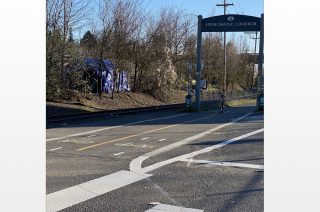
PBOT spokesperson Hannah Schafer said the changes came through their “Missing Link” program — a modest pot of money (usually less than $100,000 per year) that seeks opportunistic upgrades to city bikeways. Schafer said the new striping should handle crowds of users better and might even help reinforce existing “No Parking in Bike Lane” signage.
We’ve raised a flag about truck drivers and dangerous loading behaviors in this area a few times going back to 2008 when we reported how the trucks make the gap “perilous”. In 2012, as the problem persisted, we forced PBOT to step up parking enforcement.
Reese is hopeful the latest striping will finally do the trick. The big buffered section where they park the most now has cross-hatching marks that should discourage parking. She also appreciates how the markings make more complete bikeway connections and help encourage walkers and bikers to hold their lines.
If you ride or walk through this area, please be cautious and respectful of other people. And let us know how the new striping works for you.
— Jonathan Maus: (503) 706-8804, @jonathan_maus on Twitter and jonathan@bikeportland.org
— Get our headlines delivered to your inbox.
— Support this independent community media outlet with a one-time contribution or monthly subscription.




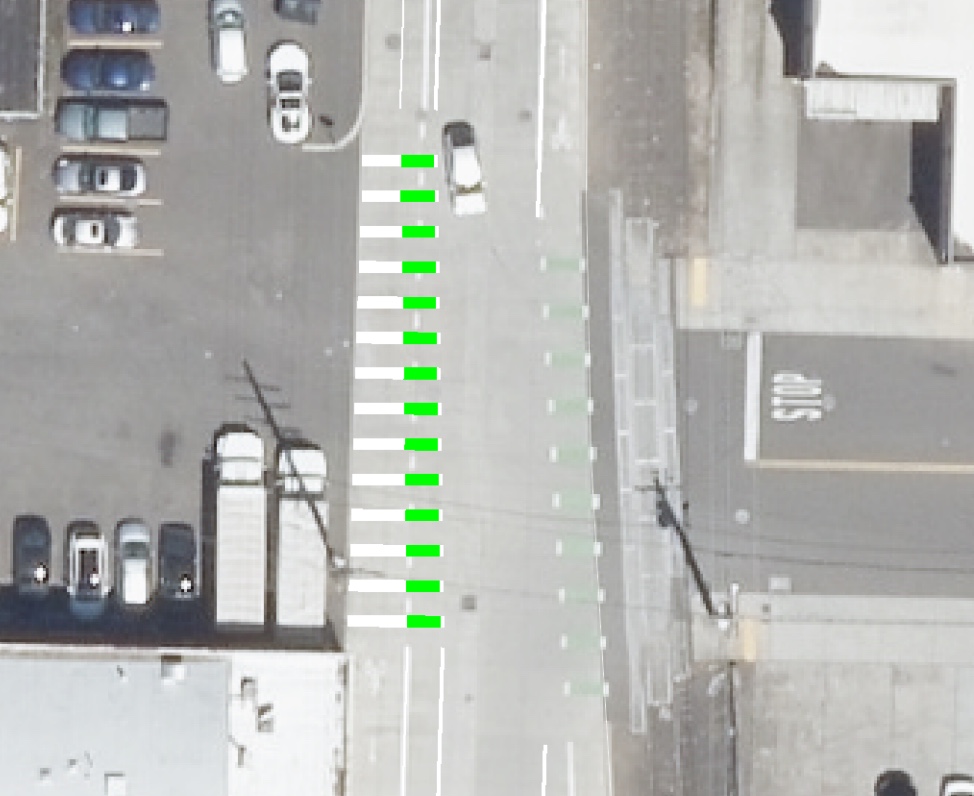
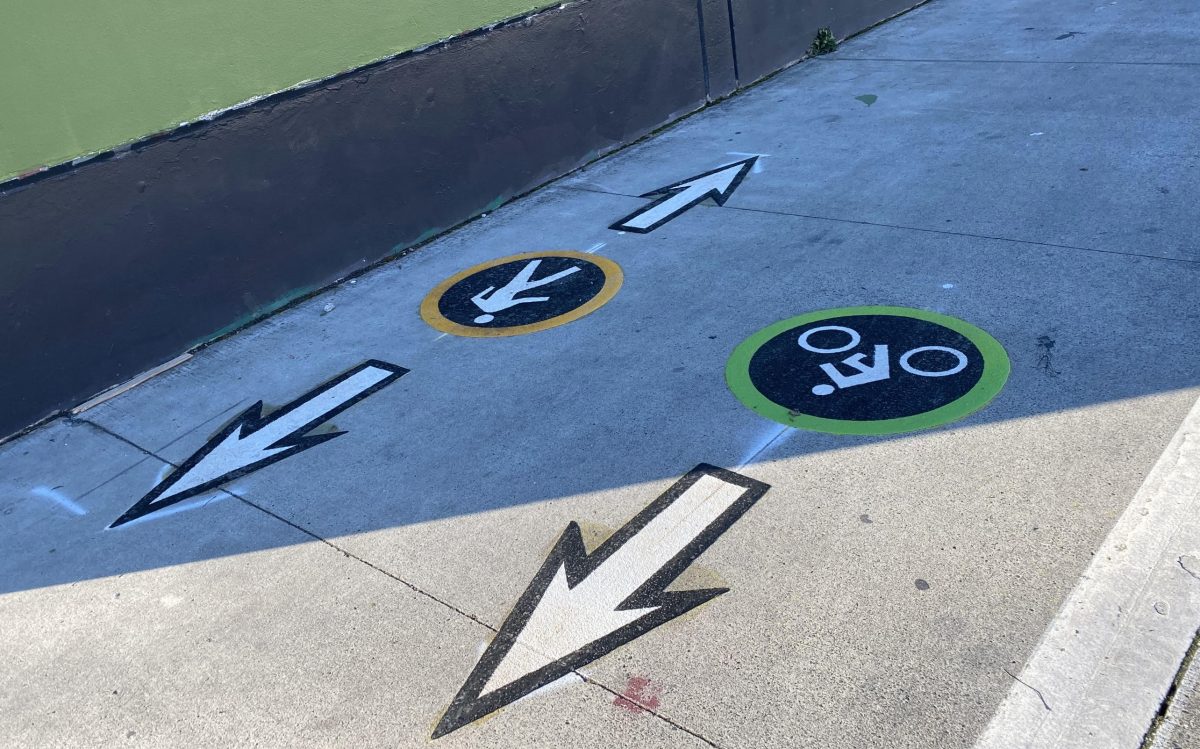
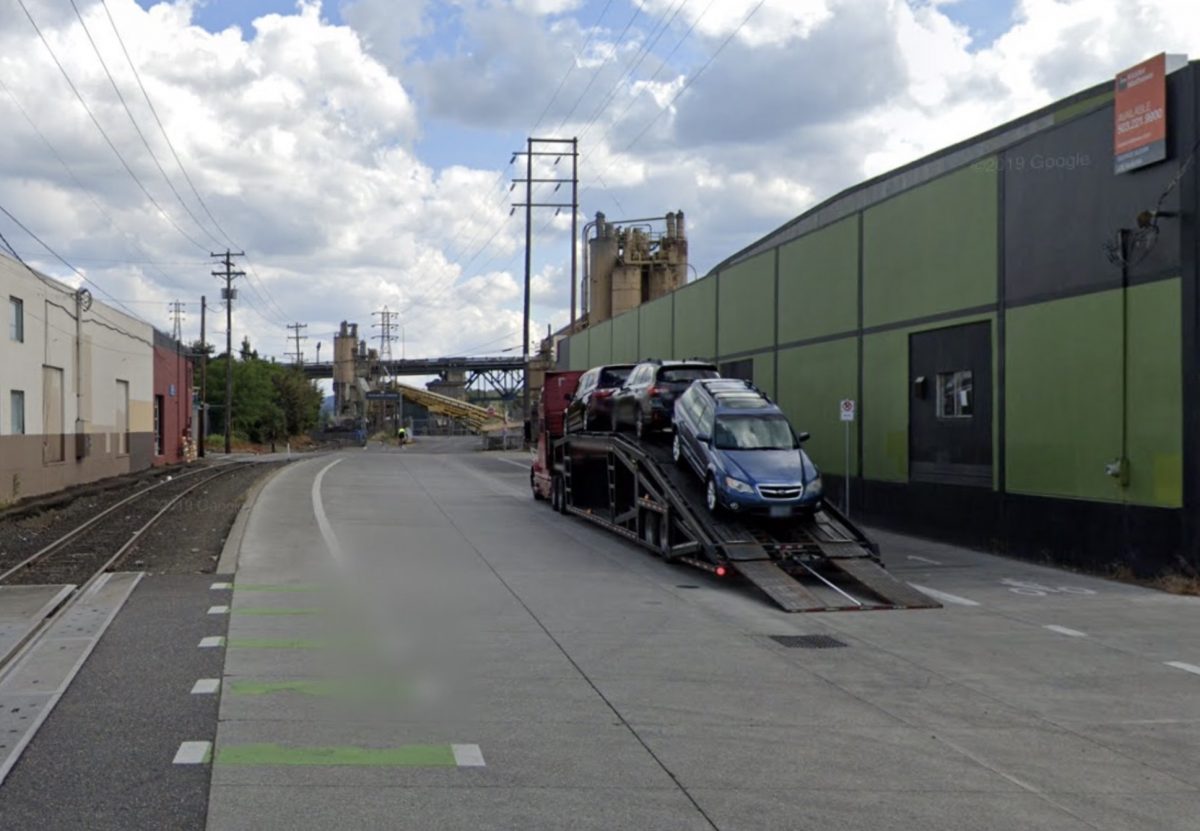
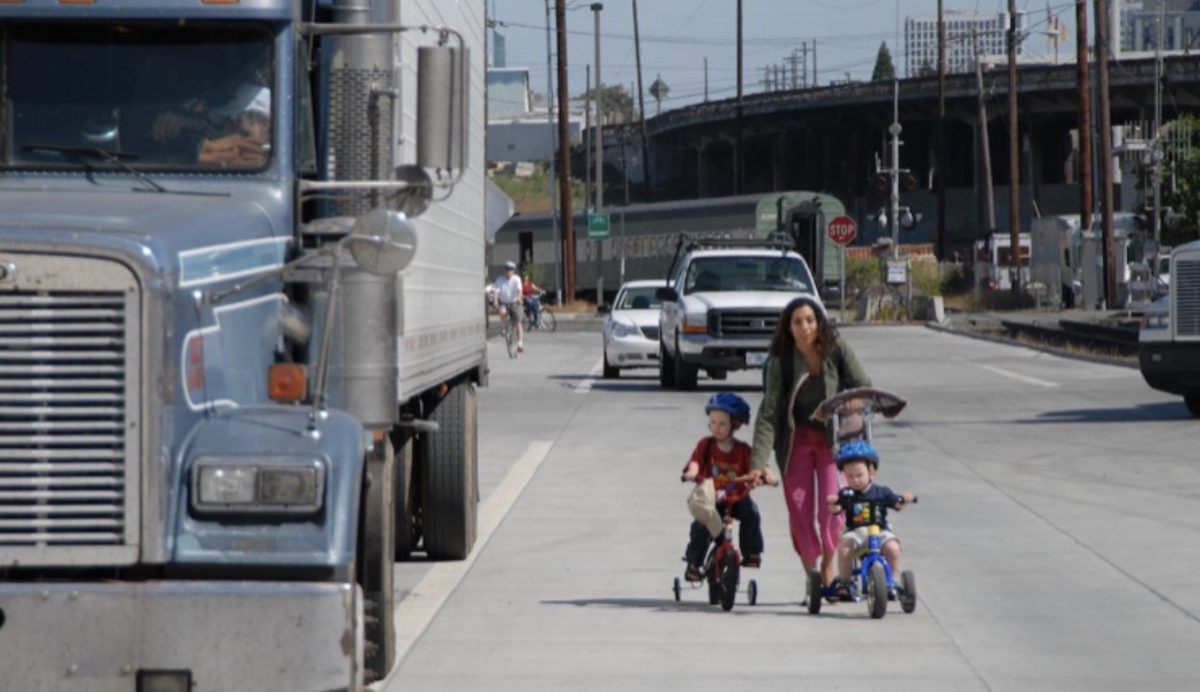
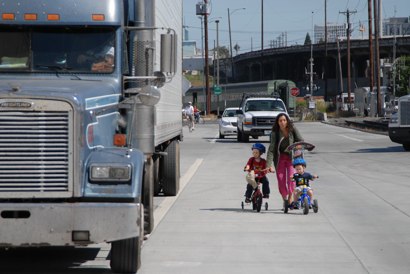
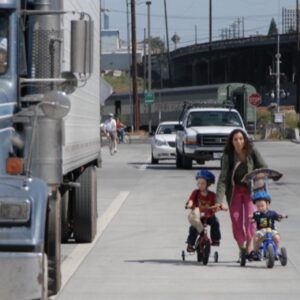
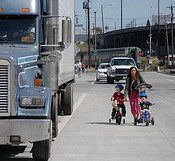
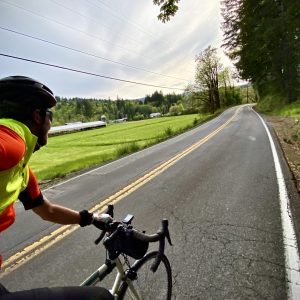
Thanks for reading.
BikePortland has served this community with independent community journalism since 2005. We rely on subscriptions from readers like you to survive. Your financial support is vital in keeping this valuable resource alive and well.
Please subscribe today to strengthen and expand our work.
Just rode by and I see one of these big Tesla car carrier truck rigs parked offloading right in the middle of that crosshatch Bike/Ped Lane buffer area with bicyclists and pedestrians passing them on either side. I guess I was too optimistic too soon. What to do?
Paint does not equal physical separation.
Hopefully that means my dual motor Model 3 has arrived!
What a selfish thing to say. Hopefully you don’t park that thing illegally.
Tweet at Elon Musk. I’m sure he’ll get right on it.
He’d be happy to bore a tunnel under the road to alleviate the conflict, for the right price.
I guess we’ll just have to be grateful they are unloading Teslas and not Hummers. I’d say contact the PBOT and ask for some enforcement but we all know PBOT/Hardesty and the rest of Portland government entities are not into making people actually follow the laws they create. That would be inequitable to the lawbreakers.
Why? The new Hummer is electric!
It consumes just as much energy to get around as the old hummer. Many more KWH/mile than the Tesla consumes. If you’re driving an electric hummer in Portland, most of those KW come from fossil fuel sources.
Because Portland gets most of its power from PGE, which gets most of its power from coal and natural gas:
Of the power generation capacity that is owned by PGE, 2/3 is fossil fuels. PGE purchases 33% of the power that it distributes from other sources that it does not own. Even if the majority of the power that PGE purchases is from renewable sources, such as hydro, that still means that Portland’s electricity is at least 47% percent fossil fuel derived. I would hazard to guess that it is much higher than 47%, based on the PGE graphic and the State of Oregon graphic that you linked to. But I can’t say for sure.
Check out page 6 (which is page 8 of the pdf) for a detailed breakdown of Multnomah County’s electricity sources as of 2008. This is much more specific than PGE’s rather ambiguous breakdown, and it paints a much bleaker picture. Multnomah County was getting 68% of it’s power from fossil fuel at that point.
Now, new wind generation capacity has come online in the last decade and PGE is in the process of decommissioning the Boardman coal power plant. But I believe that PGE has also been investing in new natural gas power generation capacity in the intervening years.
https://www.portland.gov/sites/default/files/2019-09/climate-data-report-final.pdf
Over the 3 years spanning 2014-2016, Portland got 63% of its electricity from fossil fuels (see page 13).
Even if true, electrification is still a win. Electric cars use energy much more efficiently, and also “automatically” get greener as our electricity mix gets better (which it will continue to do). They also emit less pollution locally, where lots of people are.
Gas powered cars probably become less efficient over time as they wear out.
Sure. Absolutely agree that if you hold all things equal, electrifying is always going to be a better choice than gas or diesel power. If you are trading a gas powered hummer for an electric hummer, that’s a huge win. If you’re trading an old Prius for a plug-in hybrid or a Tesla Model 3, that’s a big win.
But trading a Prius or even a mid-size non-hybrid sedan or small truck for an electric hummer is not a win. If more than half of your power generating mix is coming from fossil fuels and you are consuming a massive amount of power to move your massive vehicle, you are not doing the environment any favors by opting for an energy-hungry behemoth.
There are marginal losses in fuel efficiency as cars age, that’s true. But I had a 13 year old first generation honda insight with a failing battery and 100k+ miles that could routinely do better than 65 MPG when I got rid of it.
And it’s not as if those electrons are growing on trees. You have to spend a lot of money to build the generation and transmission capacity to get the power to the consumers. If every consumer is gobbling up energy in the largest amounts possible, it will never be possible to meet the demand with renewable energy at the rate that we are bringing it online.
I agree that a smaller vehicle will (almost) always be more efficient than a larger one within a fuel class, and we’re going to need to focus a lot on the efficiency side if we’re going to make meaningful progress on emissions.
I was most arguing against the belief that some have that switching to an electric vehicle is pointless because some of our power still comes from coal. It would be better if it didn’t, but electrics are an improvement in most parts of the US with today’s fuel mix. This is more true in the PNW.
Yes, and coal is becoming a smaller and smaller component of our fuel mix over time in the PNW and nationally. At this point, the only parts of the country where switching from gasoline power to electric would likely be a net negative due to GHG emissions from coal are West Virginia, Kentucky, Indiana, and Tennessee.
I do think that the jury is still out on the benefits of switching from coal to natural gas, which is what PGE is doing to make it possible to phase out coal. Recent revelations about fugitive methane emissions from drill sites and collection systems are alarming. The GHG impact of natural gas may be no better than coal on the aggregate when you factor those loses in. The technology exists to reduce much of these loses, but industry and regulators have failed to implement it.
Regardless, we already have a pretty sizable renewable component to Portland’s power generation, and that will only increase over time due to government mandates. Most other states, including some red ones, are also mandating that at least some of their power come from renewable sources. So the benefits of electrifying will only increase in the coming years. But the American desire for massive trucks and preference for modifications that make them even less environmentally friendly could offset a lot of the gains that can be made by electrifying our vehicle fleet.
If you want a comparison to the first generation Insight (65 MPG) or a modern Prius (50+ MPG), look at the Chevy Volt. It was a plug in hybrid that got the equivalent of 40 MPG (EPA rating) and it is no bigger than a Prius. You don’t automatically get better energy economy just because you are electrifying.
Lower emissions locally is a good point. Electrics absolutely do better on that end.
I haven’t been through to check out the changes and I’m not a truck driver but, based on the pictures, that cross hatched section is probably exactly where I would park if I were unloading a large truck in that area. The markings say to me that this spot isn’t for traveling through and it’s probably the least bad option for parking my truck.
Do they really just unload the Teslas here and drive them over the bridge to the dealer in the South Waterfront? Why did Tesla buy a dealership location that requires illegal offloading of millions in product?
They used to park those trucks in the right lane of Macadam in front of the showroom to unload and it would back up traffic and transit on Macadam for ages. Your point still stands, it’s poor sense to locate a car lot in a location you can’t easily supply.
This is so ironic and hypocritical. Tesla made a big display of putting in the section of Greenway Trail at their Macadam dealership, even though their work on their building didn’t trigger a requirement to build it. But then when the spotlight isn’t on them, they block this trail on the other side of the river.
It reminds me of PBOT’s publicly polishing its image as being pro-biking and walking, but out in the field their vehicles with their orange “VISION ZERO” bumper stickers are regularly parked in the middle of bike lanes and sidewalks.
That’s boring.
Good one!
Tesla has a storage facility near SE 4th and Division Place. They eventually go across the river but are initially received and stored on the east side.
I’ve ridden through there for years and have never thought it was that much of a problem. Trucks parked haphazardly in the area (some in the middle of the road, some on either side) cause motorists to pay attention and slow down. I thought that’s what we all wanted.
Hard to call it an all ages/abilities network if you allow vehicles to obstruct the road in a way that forces users to leave the marked pathway and merge with traffic. Yes, it’s less of an issue in low speed, low traffic volume areas. But it’s still a problem. And if we build a culture of impunity when it comes to parking and unloading illegally, the problem will inevitably become more widespread.
When that haphazard parking and unloading extends to Amazon and FedEx trucks blocking bike lanes on major arterials, as it often does, it creates a massive safety issue.
I’ll gladly take some illegal parking that turns a short section of street into a woonerf instead of the culture of impunity (I like your phrase) that accepts motorists blowing red lights and driving 30 mph on my neighborhood streets.
Fair point. People facing no consequences for choosing to disobey traffic control devices does seem to be a much bigger safety issue.
I love your “culture of impugnity” also. But while I agree with JR about the illegal parking being less of an issue than speeding, etc. it’s driven by the same impugnity, so in a sense is no less excusable. Every person who parks blocking a bike or walking route excuses themselves with “It’s just this once, it helps me and doesn’t really hurt anyone”–the same as people deciding to speed or drive while doing “only” one or two texts. But many people each taking that same attitude does create real problems.
Nice job, Betsy Reese, on the overhead photos! Were they taken with a drone?
those are PBOT plan drawings fred.
Why does contrivance have to be the Tilikum brand?
I’m hardly the biggest fan of contraflow and/or protected lanes, but a contiguous two way path from Springwater’s trailhead to the bridge and Esplanade seems like the blindingly obvious solution. Cross at the bridge and you’re done without so much as grazing hot buttons like freight or parking as far as I can tell.
What’s bad about contra flow bike lanes? Just curious. I used them in Montreal and they seemed to work well.
I find it disorienting to sit between two lanes of oncoming traffic.
Much like a shark cage, I’m thinking less about the protection than the danger, and on a two-way path it’s pulling my attention away from where it needs to be.
As much as the trucks parked in the street, and parents picking up youth rowers parked in the bike lane are a problem, the greatest hazard in this area is still speeding drivers rushing to get onto Hwy 99. Many far exceed the speed limit, dive blindly through corners, and run stop signs to rush into rush hour on the highway. I’ve talked directly with police and with PBOT about this issue and it continues to be my greatest worry. There are daily regulars who are reckless, we see them daily turning off of 4th onto Ivon at about 35mph or more, cutting the corner, drifting up to the on ramp. Then, there are those that are clearly lost who drive up to the closed Ross Island gate, u-turn across the bike lane and then head toward 99. All while distracted by their phone/nav device and not really paying attention to peds and bikes. Then, we have the motor sport business that tests products in this section of street – sometimes recklessly burning rubber, doing donuts, etc. The new paint is great in that it will help clarify pathways for bikes and peds but it will not really make this 3 block section of road any safer as the hazard created by reckless drivers is still present.
Give drivers any big, open stretch of pavement, and they will abuse it. It’s a universal rule of driving.
Hell yeah! Truckers hate cross-hatch paint markings. This’ll do the trick.
lol! comment of the week
The Springwater has much more problems than a semi illegally blocking a bikelane for an hour or so every week…
That is a solid point.